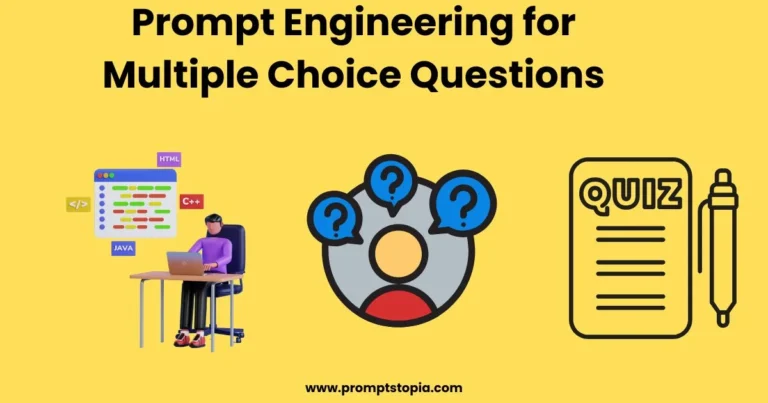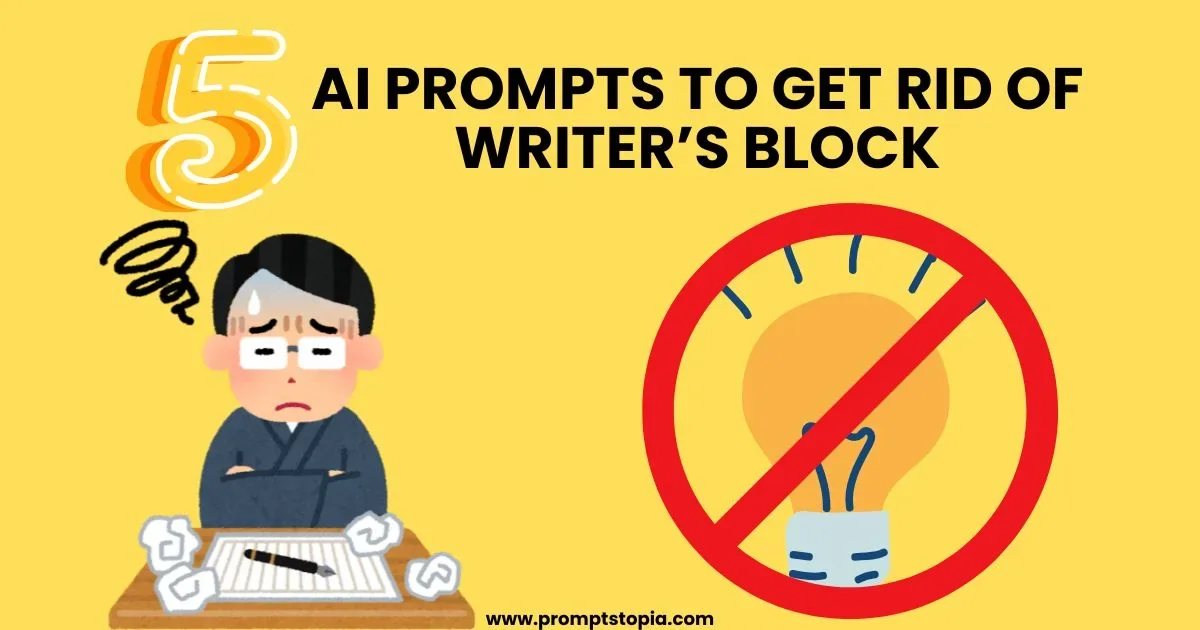Multiple-choice questions tend to appear challenging in general, particularly if you wish them to be clear, interesting, and fair. Good multiple-choice questions (MCQ’s) have always been an exercise that I really found very difficult to do, as they easily resulted in questions that were either too easy or too hard to understand. The benefits of prompt engineering for multiple-choice questions were then explained to me.
So, what is prompt engineering? It’s the fine art of designing precise inputs or instructions to feed into AI systems in order to produce accurate outputs that fit the given context. Applied to multiple-choice questions, it simplifies the process, making sure well-structured questions with clear stems and plausible options.
While being a tool of assessment, effective MCQs also serve as a means of learning in knowledge-based assessments since they aid in testing knowledge and pinpointing any gaps in learning. However, crafting effective multiple-choice questions requires a systemic approach. This is the exact point at which prompt engineering becomes necessary in order to further direct AI in generating high-quality questions while minimizing manual labor.
It actually made my job faster, more creative, and more consistent—and thereby turned something that used to feel a little hard into a fun and efficient job. Let’s discuss some of the ways through which it works as well as why it might be important.
Understanding Prompt Engineering for Multiple Choice Questions
Prompt engineering involves the careful creation of instructions to control or guide AI systems toward generating sensible outputs. Especially in assessments, testing, and training within education, it means the AI tool will produce content that is relevant, engaging, and suitable for particular learning objectives. In the field of prompt engineering for multiple-choice questions, the approach becomes even more valuable in effectively developing an assessment and quiz.
The key advantage of prompt engineering is in streamlining the process of coming up with clear and well-rounded MCQs. In this way, you will avoid guesswork and produce quality questions within the shortest time possible. You can set clear criteria for your prompts, such as topic, difficulty level, or answer structure.
Some examples of prompts that can help AI produce questions are:
- Develop an idea around a subject like: Describe how photosynthesis works.
- Provide one correct answer and three plausible distractors, such as common misconceptions about the topic.
This method of organization prevents disadvantage and guarantees similarity in the creation of questions. It is no wonder that prompt engineering frameworks have become a go-to method for educators and trainers looking to enhance learning experiences efficiently. Prompt engineering speeds up and saves time while maintaining the quality of guidance, whether you’re creating tests or using resources like a lesson plan generator.
Benefits of Using Prompt Engineering for Multiple Choice Questions
This brings so many advantages when creating multiple-choice questions. Here’s why it is quite special.
Ensures Diverse and Unbiased Questions
With prominent prompts, you can guide AI to come up with so many varied types of questions that target different learning styles and thus minimize any repetitive and biased content. This will make sure fair assessment for all learners.
Saves Time While Maintaining Quality
Manually completing this can take a significant amount of time. With prompt engineering, it is accelerated with an AI doing most of the work but without compromising on the quality of the questions
Customization for Specific Topics or Audiences
A good prompt builder will assist you in customizing questions to particular topics, skill levels, or even the tone of your audience. For example, you can create MCQs for beginners on foundational concepts or challenging ones for advanced learners.
Example in Action
Suppose you wish to make a number of multiple-choice questions in biology. With the help of prompt engineering, you can ask the AI to
- Create questions on the human respiratory system.
- Make sure there is at least one correct answer and three distractors that capture popular misconceptions.
- This level of customization ensures that your MCQs will exactly meet your educational objectives.
Prompt engineering alone would help increase the effectiveness of your own multiple-choice question creation efficiency but, more importantly, allow the delivery of relevant, balanced, and engaging questions for learners.
Steps to Write Effective Prompts for Multiple-Choice Questions
Creating effective multiple-choice questions using prompt engineering requires an analytical approach. To make your prompts more precise and clear, follow these steps:
Start with a clear concept:
Define the subject matter the MCQ will cover. Be as specific as possible to avoid wrong or irrelevant questions.
For example: “Create an assignment on the water cycle with a focus on evaporation.”
Specify Question Style
Identify the question type involved: factual, conceptual, or situational. This will guide the AI that is answering in terms of what to aim for.
Define Answer Structures
Identify the number of alternatives presented with the question. There should always be one correct answer and several plausible distractors. Indicate whether the distractors are meant to exemplify common misconceptions or creative twists.
Example: “Include one right answer and three distractors that are based on common misconceptions of Newton’s Laws.”
Add Difficulty or Creativity Criteria
Specify if the question should be entry-level, intermediate, or advanced. Include qualities such as the word count requirement or whether it should be fun or straightforward.
Combining these steps together will provide clear and effective prompts, guiding the AI to produce high-quality MCQs tailored to your demands.
Common Mistakes to Avoid in Prompt Engineering for Multiple Choice Questions
However, when developing multiple-choice questions (MCQ’s) with prompt engineering, there’s a very good chance of avoiding common risks that will help improve your results. Here are some things to avoid:
Vague Prompts Resulting in Unclear Answers
Ambiguous instructions can end up in confusing or irrelevant questions. Be specific about the topic, format, and answer structure to guide the AI properly.
Overly Complex Wording
Too much jargon or overly complicated phrasing can confuse both the AI and the intended audience. Make sure the prompts are clear and concise.
Poorly Designed Prompt
A poorly worded prompt like “Generate a question about science concepts” could result in a generic question like “What is science?” instead of a more specific question, such as “What are the phases in the water cycle?”
Additionally, using roles in prompt engineering can help clarify the type of question you want to generate, ensuring more accurate and relevant outputs.
Tools and Techniques to Enhance Prompt Engineering
To fine-tune the creation of MCQ, you might want to include AI tools and techniques to reduce processing time but improve your output:
AI Tools for MCQ Generation
Tools like ChatGPT are excellent for quickly generating multiple-choice questions based on your prompt. You can specify topics, difficulty levels, and even answer structures.
Testing and Tweaking AI Responses
Test and fine-tune the MCQs generated from AI regularly so that they become of higher quality. Tweak the prompts based on responses to fine-tune the final outcome.
Add human creativity
As AI can generate questions, your creativity will help ensure that the resultant MCQs are exciting and educational. One example is using various styles of questions or involving “what if” scenarios to enhance their learning capabilities.
Elementary School Multiple Choice Questions Prompts
Prompt 1: Elementary School Mathematics
“You are a professional quiz creator, and you must make multiple-choice questions for primary school students about common multiplication and division. The problem should have two single-digit numbers. Include one correct answer and three plausible distractors representing common addition errors.”
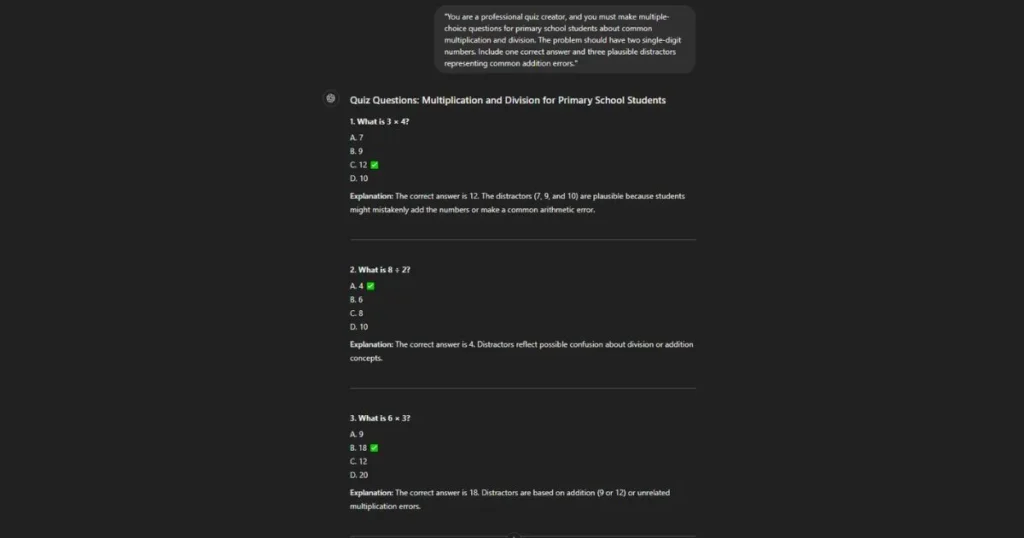
Prompt 2: Elementary School Science
“Act as a professional quiz creator, and you need to create multiple-choice questions about phases of the water cycle for students. Concentrate on the evaporative process. Include one correct answer and three distractors representing common errors about the cycle.”
Prompts for College Multiple Choice Questions
Prompt 3: (History)
“Act as a professional quiz creator, and you need to create multiple-choice questions about the causes of World War 2. The question should focus on alliances and treaties. Include one correct answer and three distractors based on key historical events of the period.”
Prompt 4 (English Literature)
“It is your responsibility as a professional quiz creator to develop a scenario-based multiple-choice question for college students studying Shakespeare’s “Macbeth.” Attract attention to the concepts of fate and desire. Offer one correct answer and three plausible distractors representing different explanations of the themes.”
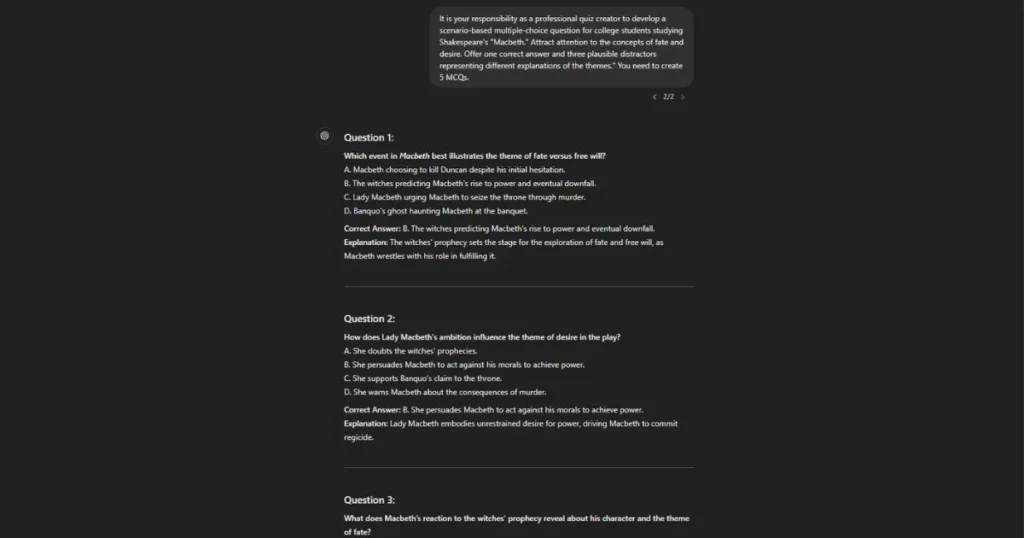
Prompts for University Scenario-Based/Conceptual Multiple-Choice Questions
Prompt 5: (Business)
“You are an expert quiz creator and you need to create a conceptual quiz for university students about company operation. Use actual employee behavior problems. According to several ethical theories, use three distractors and one right answer.”
Prompt 6: (Psychology)
“As a skilled quiz maker, it is your responsibility to create scenario based multiple choice questions on split minds and common psychosis for university-level students. The question should be framed as a dilemma in which the individual character comes to experience incompatibility between her beliefs and her practice. One correct answer and three distractors based on psychological theories.”
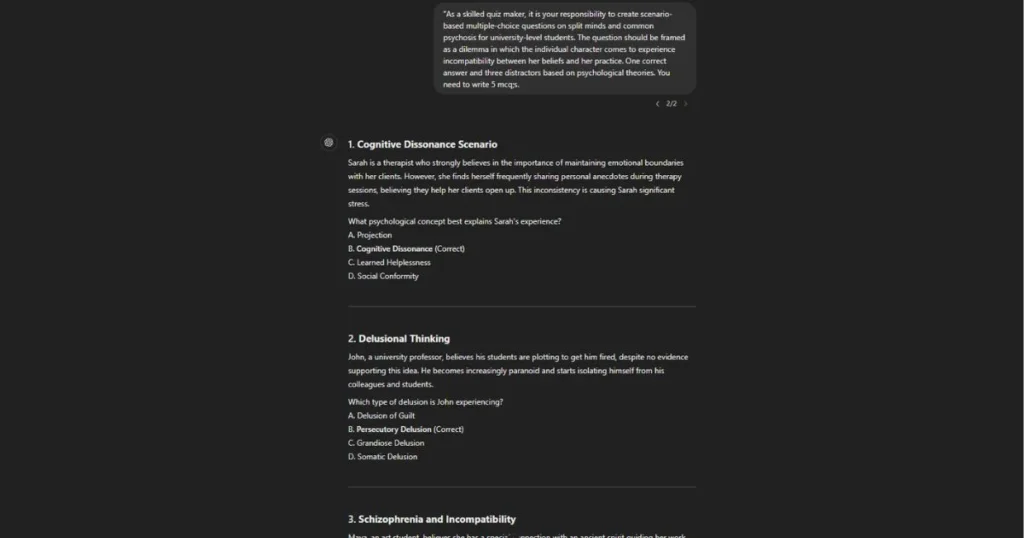
Conclusion
Prompt engineering for multiple choice questions is a powerful tool that helps educators, trainers, and content creators design effective, relevant, and engaging multiple-choice questions. You can simplify the process by creating clear, structured prompts to create diverse and unbiased questions that can meet the different needs of learners. Remember, prompt engineering for multiple choice questions is not about replacing human creativity it’s about enhancing it.
I encourage you to try and craft some of your own (MCQ) prompts. Start simple, refine your approach, and see how AI can support your educational goals. Whether for students of elementary school or in university, well-designed prompts will save you time and improve the quality of your MCQs. The options for crafting scenario-based questions and writing prompts for students are practically infinite.
FAQ’s
The following simple instructions will help you to use ChatGPT to create multiple-choice questions and, honestly, pretty much any other challenging task: As much as you put in, you get out. ChatGPT doesn’t entirely replace work but can significantly reduce the amount of effort needed to complete a task.
Although ChatGPT can provide precise multiple-choice questions, the AI’s output relies on timely clarity and specificity.

